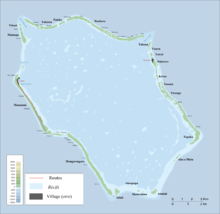- Penrhyn (atoll)
-
Lady Penrhyn Native name: Tongareva
Aerial view of Penrhyn.Geography Location Central-Southern Pacific Ocean Coordinates 9°00′20″S 157°58′10″W / 9.00556°S 157.96944°W Area 90 km2 (35 sq mi) Country Penrhyn (also called Tongareva, Mangarongaro, Hararanga, and Te Pitaka) is the most remote and largest atoll of the 15 Cook Islands in the south Pacific Ocean.
Contents
Geography
Located at 1,365 km (848 mi) north-north-east of Rarotonga, 9 degrees south of the equator. It sits atop the highest submarine volcano in the Cooks, 4876 m (15,917 ft) above the ocean floor. It comprises a ring of coral 77 km (48 mi) around. The lagoon covers 233 square kilometres (90 mile²) of which 62 square kilometres (24 mile²) is covered with pearlshell.[1][2] Land area is 9.84 square kilometres (2,432 acres). Maximum elevation less than 5 m. Population according to the 2001 census was 357.[3][4] As of 2006 the population of the island has shrunk to only 200 or so inhabitants according to the current mayor of the island.[citation needed]
People & culture
Villages
Penrhyn Atoll has two villages. The main village of Omoka, seat of Penrhyn Island Council, is on Moananui Islet, on the western rim of the atoll, north of the airport. The village of Te Tautua is on Pokerere Islet, on the eastern rim.
The religion of the inhabitants of the island is notoriously divided, 75% of the population belong to the Cook Islands Christian Church while the remaining 25% belong to the Roman Catholic Church.
History
Etymology
Penrhyn's original name is Tongareva. Academic research published by the Cook Islands Library and Museum says this is variously translated as "Tonga floating in space", "Tonga-in-the-skies" and "A way from the South". However, the most commonly-used name in English is Penrhyn after the Lady Penrhyn commanded by Captain William Cropton Sever who landed on 8 August 1788. Another European name was Bennett Island.[5] The Lady Penrhyn was one of a fleet of 11 ships which sailed from the Isle of Wight (off the south coast of the UK) to found the earliest convict colony in Australia
Slavery
In 1864, Penrhyn was almost depopulated by Peruvian-Spaniard expeditions. An estimated 1,000 men, women and children were taken to South America. Native pastors of the London Missionary Society had introduced Christianity from Rarotonga in 1854, the new religion had been accepted enthusiastically, and the villagers immediately started to build churches. Promise of good pay and safe return from the slavers offered a way to obtain money for churches, but most died in exile, virtually slaves.[6] Another source states that, in 1863, 410 inhabitants of the total population of about 500 were kidnapped by blackbirding by the Peruvian-Spaniard explorers who were assisted by four native missionary teachers, who sold the populators for 5 dollars per capita. The missionaires accompanied the slaves to Peru as their interpreters. [7]
Foreign claims
From 1856 to 1980, the United States claimed sovereignty over the island under the Guano Islands Act. In 1980, the U.S. signed a treaty with the Cook Islands in which it acknowledged that the island was under Cook Islands sovereignty.
Economy & resources
During World War II, a substantial airstrip was built, which is still used today although flights to the atoll are not regular.
A large passage in the lagoon allows inter-island ships to enter the lagoon, and the island has become popular as a stopover for yachts crossing the Pacific from Panama to New Zealand. The inter-island Taio shipping company visits the island approximately every three months.
Black pearl farming
Black pearl farming is the only significant economic activity on the island. The locally produced Rito hats, woven from coconut fibre, are considered the finest in the whole South Pacific. The fibre is from young coconut leaves which are stripped, boiled and dried resulting in a fine white leaf. Called rito weaving, the traditional items woven are Sunday church fans, small baskets and hats, the hats being a copy of the ones the sailors wore.[8]
Food
The present population of the island rely on the ocean for most of their food as well as locally grown plants such as coconut and breadfruit. Every morning (except on Sundays) men from the island head out in small tin boats to spear or trawl for fish for their families. The islanders' diet is supplemented by imported rice and flour shipped in from Rarotonga. The boats are infrequent (usually every 3 months); however, the boat is often late and the people of Penrhyn are forced to make do with what food they can provide for themselves.
See also
- List of Guano Island claims
References
External links
Coordinates: 9°00′20″S 157°58′10″W / 9.00556°S 157.96944°W
Northern 
Southern - Nga-pu-Toru Southern - other Categories:- Atolls of the Cook Islands
- Islands claimed under the Guano Islands Act
- Former regions and territories of the United States
- Territorial disputes of the Cook Islands
- Disputed islands of Oceania
- Penrhyn (atoll)
- Cook Islands–United States relations
Wikimedia Foundation. 2010.



